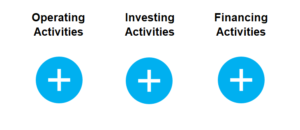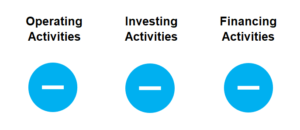An income statement (a.k.a. profit and loss or P&L), balance sheet, and statement of cash flows comprise a typical set of financial statements. While most people are familiar with the first two, the latter is a financial statement often left to the professionals. Having a comprehensive understanding of the statement of cash flows may not be that necessary, however, just a tad of cognizance will help you pick out important data about the health of your company.
What is a cash flow statement?
A cash flow statement reconciles your beginning and ending cash balances and shows you what activity transpired during the period to increase or decrease your cash balance. The overall purpose of knowing what activity increased or decreased cash is to provide a clear picture of your company’s ability to operate in the short and long term based on the funds available to cover itself.
A statement of cash flows consists of three main sections: cash from operating activities, cash from investing activities, and cash from financing activities.
Cash flow from operating activities
Cash from operating activities includes any sources and uses of cash in the regular course of operations. It answers the question, how much cash is received and spent from what my company does to generate income? This section typically includes receipts from sales of goods and services, payments for goods purchased from suppliers, salaries and wages paid to employees, and other operating expenses.
Cash flow from investing activities
Cash from investing activities includes all cash activity of company investments. Items typically reported in this section are the purchase or sale of fixed assets, acquisition or disposition of investments (subsidiaries, etc.), or paying off or lending from or to someone other than what is used or needed for the company.
Cash flow from financing activities
Cash from financing activities includes all financing received or paid. It can be receiving the principal amount from a loan, paying off a loan, taking distributions from the company, or an injection from a new equity partner.
How is the statement of cash flow prepared?
The direct and indirect methods are two models that can be applied to prepare the statement of cash flows. Without getting too focused on minutiae; the cash flow statement is prepared by utilizing the income statement and a comparative balance sheet. Net income is taken from the income statement, while most other numbers are obtained by finding the difference between balances from a comparative balance sheet.
Core indicators
Each of the three sections in the statement of cash flows will have a total. You will have a sum for operating, investing, and financing activities. These totals will either be a negative or positive number. Looking at the numbers and specifically, if it is a negative or positive number can tell a lot about your organization’s health and ability to sustain in the long run.
The most important indicator is the “net cash flow from operating activities” figure. If this amount is positive (and generally a high number), you are cash flowing from what you do every day. Let us illustrate by example. If you sell bananas at a stand and your net operating cash flow is positive, it means that selling bananas is generating a positive cash flow for your company. If you do newspaper delivery in the afternoon and your net operating cash flow is negative, it means that your main operation, delivering newspapers, is not bringing in enough cash to cover itself.
Having a negative total or a too little total from operating activities is considered a red flag. You spent too much on operations compared to what you received from your operations. You will need to implement strategies to help you get into a positive operating cash flow. Be aware that a negative from operating activities does not mean that the company’s cash flow is negative; what it means is that your business operations do not create too much cash. Referring back to our newspaper delivery example. If you sold your bike for $200, you will end up with positive overall cash, but it will not be coming from your main operations – a real issue.
Analyzing the indicators
Consider the following two aggressive scenarios.
Scenario #1: Company ABC has all three sections from the cash flow statement at a substantial, positive number. Being all positive indicates that their sales are bringing in cash (operating), they sold equipment (investing), and they acquired financing (financing). This company may have a lot of extra cash sitting in reserve, and it may be a good time for expansion.

Scenario #2: Company XYZ has all three sections from the cash flow statement as a substantial, negative number. Being all negative indicates that the company is using cash reserves to finance shortfalls in cash from operations and pays back lenders and/or investors. The company is in a critical, cash flow stage.

Each company has its unique cash flow scenario that is analyzed differently. The three sections can create eight different scenarios and there are different factors in each company that determines it. Analyzing a cash flow statement is an integral aspect of proper financial planning. Your cash position will tell you if it’s time to hire more employees, consider financing or an equity partner, buy equipment or become more aggressive on collections. After all, 82% of small businesses fail due to cash flow problems.
Cash flow planning
Forecasting your income and expenses for the future will help you identify earning goals, however, this should not be substituted for cash flow forecasting. Profit does not equal cash. Profit is what is left from sales after deducting your expenses, yet cash is what is needed every day to operate. You can estimate your cash flows based on current and historical trends which will help you avoid cash shortfalls. Determine what day of the month you pay your employees and loans, what your vendor credit terms are, how soon you can see a payment from customers based on your collection policy, and more.
If a business falls short of cash, it may have to satisfy expenses by pulling cash from other sources, such as owners’ savings, quick and expensive loans, etc. But, this is just a quick solution. If your company continues to operate without bringing in more cash than it is spending, cash reserves will be used up and your continuity will be in question. With proper planning, you can always go back to your original forecast and compare it with the actual to determine what went wrong and how you can resolve this from repeating again in the future.
Running a cash flow statement in QB
You can run a statement of cash flows in QuickBooks. However, some people find that QB has limitations with the cash flow statement since it may incorrectly categorize certain accounts. For instance, a short-term loan to an officer may be classified by QB as an operating activity when it is an investing activity. However, you can change classification by going to the “company preferences” under “reports & graphs” and clicking on “classify cash.”
Need help running a statement of cash flows, understanding a statement of cash flows, or forecasting your cash receipts and payments?
To be honest about it, a statement of cash flows may be complicated. But, that does not mean that you should not see what it tells you. Contact us here if you need help preparing, analyzing, forecasting, or understanding the statement of cash flows.

